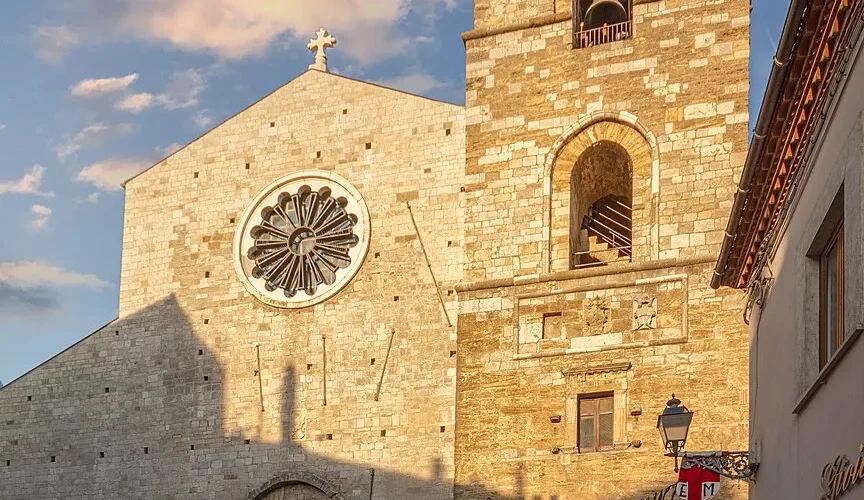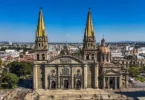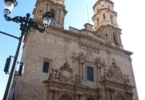Introduction
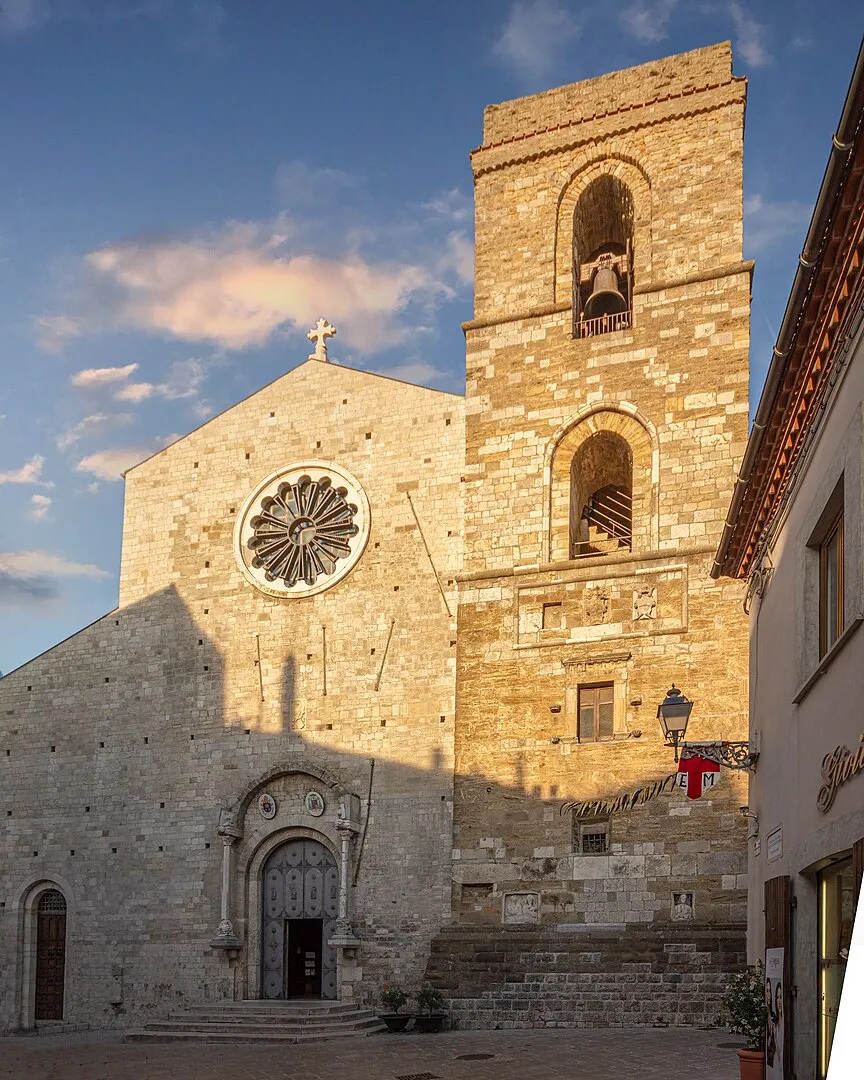
The Cathedral of Acerenza, also known as the Church of Santa Maria Assunta and San Canio, is a prominent Catholic place of worship located in the town of Acerenza, in the province of Potenza, Basilicata, Italy. It serves as the seat of the Archbishop of Acerenza and is one of the most notable Romanesque structures in the region. Dedicated to the Assumption of the Blessed Virgin Mary and to Saint Canius, the cathedral holds significant religious and architectural importance. In recognition of its cultural and historical value, it was declared a minor basilica in 1956.
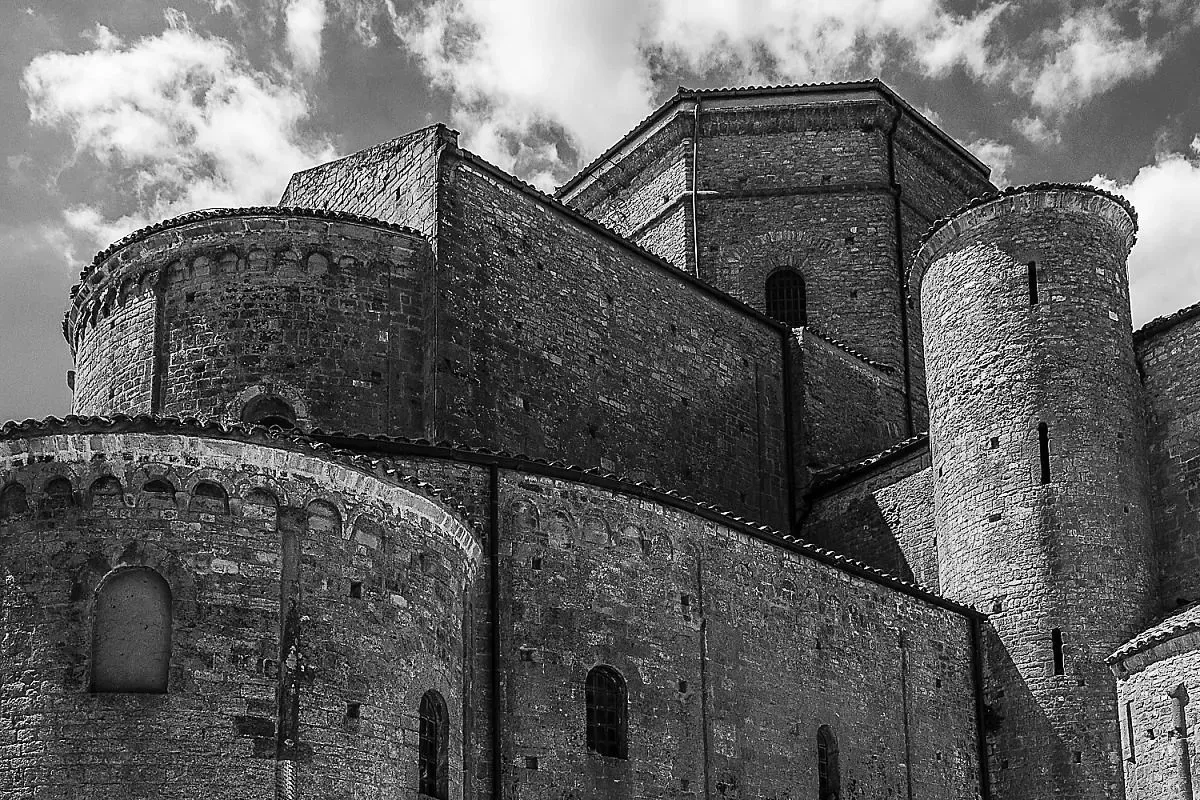
The current structure of Acerenza Cathedral was built between the 11th and 13th centuries, constructed on the remains of an earlier early Christian church, which itself was erected on the site of an ancient Roman temple dedicated to Hercules Acheruntino. The construction of the cathedral began in 1059, thanks to the generosity of Robert Guiscard and Bishop Godano, who was the first to hold the title of Archbishop. However, the work continued under Bishop Arnaldo, who, with the help of French workers provided by the Normans, completed the cathedral.
Romanesque-Gothic Rebuilding and Earthquake Damage
In 1281, the church underwent partial reconstruction in the Romanesque-Gothic style, which included a peribolos with three diverging apses, a characteristic design found in other churches throughout Southern and Central Italy, as well as a façade with three portals. Unfortunately, the cathedral sustained significant damage during the earthquake of 1456, and due to a series of non-residential archbishops, the building was abandoned for some time.
Restoration Efforts
The complete restoration of the cathedral began in 1524 at the request of the Ferrillo counts of Acerenza. Two square-plan bell towers were added to the façade, one positioned near the right portal and the other near the left portal, though the left one was later lost. In the same year, the crypt was reconsecrated. In 1555, master Pietro di Muro Lucano remodelled the right bell tower in Renaissance style, as indicated by an inscription on the tower.
20th Century Changes
After the 1921 earthquake, the dome of the bell tower was replaced with a terrace, and in 1934, the original cylindrical dome of the cathedral was rebuilt due to severe damage caused by the 1930 earthquake. During this restoration, baroque additions were removed from the interior.
In 1953, the access system to the crypt was altered, with a central staircase leading up to the presbytery and lateral staircases leading down. In 1954, Pope Pius XII elevated the cathedral to the dignity of a minor basilica. Between 1975 and 1977, the floors were redone as part of continued restoration work.
Architecture of Cathedral of the Assumption of Mary and Saint Canius, Acerenza, Italy
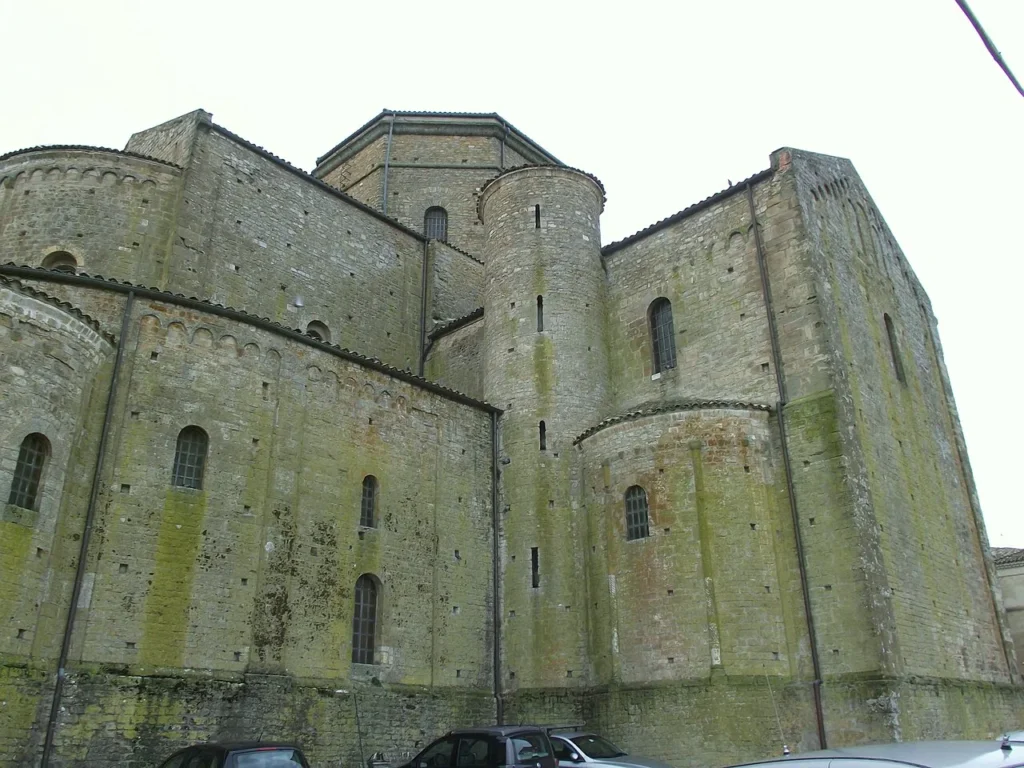
Architectural Style: Romanesque Architecture
External Features
The cathedral’s facade is divided into a central section with two slopes, with the right side disrupted by the bell tower, creating an asymmetrical appearance.
The bell tower stands on four levels, with the second level featuring a window adorned with Renaissance decorations. Additionally, there is a recessed area for an epigraph dedicated to the Roman Emperor Flavius Claudius Julianus. The tower incorporates materials from Roman sarcophagi, displaying faces of the deceased, as well as fragments of a funerary altar. It houses five bells, with the largest, dating back to 1854, created by Girolamo Olita.
Two doors lead into the cathedral’s façade. The small door on the left side, which has been significantly altered over time, is topped with a round arch and now leads to the cathedral museum. The central door, in the Apulian Romanesque style, serves as the main entrance. It is flanked by a porch that is missing several original elements. The marble columns at the base once supported two lions, but only one remains, positioned high on the left corner of the façade. The round arch that once featured half-busts of angelic figures now retains only two sections. Sculptural groups on the portal brackets depict animals—lions and monkeys—entwined around two human figures, likely a man and a woman.
Between the portal and the rose window, which was reconstructed in 1928 to replace the 1601 window designed by Lelio Potenza, lies the coat of arms of the Ferrillo family, who restored the church in the 16th century. There is also a bas-relief of a basilisk, a mythical creature that was part of the ancient city’s coat of arms. Above the façade, a recently added marble cross has replaced a marble bust of Emperor Flavius Claudius Julian, now housed in the cathedral museum.
The transept features two side apses and an apse with a peribolos, decorated with three diverging apses. The upper part of the apse is flanked by two stair towers, which house spiral staircases, with the right tower connected to the dome’s interior via an external flying buttress. The diverging apses contain shafts of spiral columns made from oriental marble, likely remnants from the ciborium of the ancient early Christian church.
The cathedral’s upper section is characterized by squared stones, which are lightened by hanging arches supported by pilasters. These stones are covered in lichens that change color as the weather shifts from dry to humid.
Interior Features
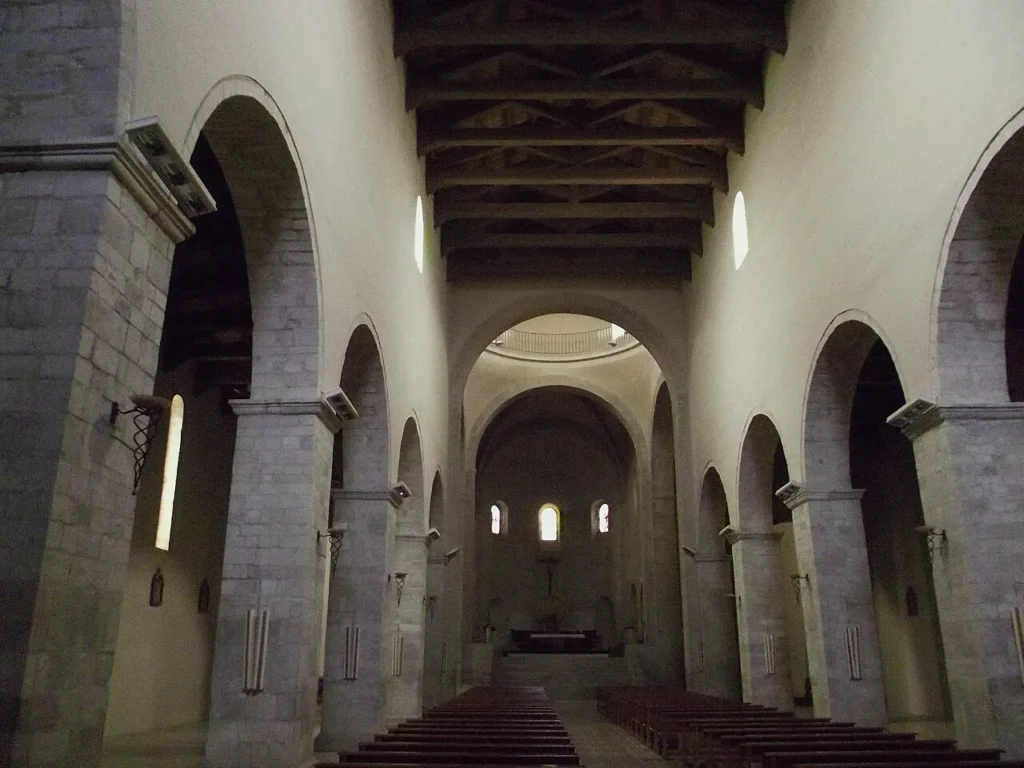
Nave and Transept
The Cathedral of Acerenza, measuring 69 meters in length and 23 meters in width, follows a Latin cross plan. It features three naves, divided by ten pillars, and a trussed ceiling. Upon entering, the right side gives access to the bell tower through a stone spiral staircase. This staircase connects to the choir above the entrance. Walking down the right nave, one encounters the sacristy door, leading into the transept, which houses two semicircular chapels at its ends.
The chapel on the right is of notable historical and artistic value, as it contains a large polyptych by Antonio Stabile from 1583. The polyptych portrays the Madonna of the Rosary with Saint Thomas Aquinas and 15 scenes from the life of the Virgin and Jesus. Surrounding the central image are 15 panels depicting the mysteries of the rosary, supported by two twisted gilded wooden columns that hold up a tympanum, which features a Holy Trinity by an unknown artist. Additionally, the right chapel hosts a baptistery with a helical fluted column under a monolithic porphyry basin dating from the 11th century.
In the left transept, there is a Pietà by Antonio Stabile from 1570, set inside a richly adorned marble arch, possibly the work of Pietro di Muro Lucano. Above the altar, a second painting depicts The Last Supper, created by an unknown artist. The baroque altar of the presbytery was reassembled in this same arm.
High Altar and Choir
Between the transept and the central nave lies the choir and the apse basin, which are highlighted by five stained glass windows from the 1930s by the Pizzirani glassworks of Bari. These windows depict San Canio, San Pietro, Santa Maria Assunta, San Paolo, and San Mariano. Below the windows, frescoes featuring floral, zoomorphic, and anthropomorphic motifs decorate the space. In the center of the choir stands a 17th-century wooden crucifix, accompanied by a high altar resting on a large Ionic capital, which was originally used as a holy water stoup.
Presbytery
The raised presbytery, elevated above the basilica’s floor, features a peribolo around the choir, onto which three radial chapels open. On the walls of the peribolo, there are cubic capitals and three partly fluted columns, all repurposed from ancient monuments. Additionally, 16th-century frescoes depicting a Madonna with child and various saints, including Saint Francis of Assisi, Saint Jerome, and Saint Peter, adorn the space.
The three Romanesque chapels with cross vaults are dedicated to Saint Michael the Archangel, Saint Mariano, and Saint Canio. The first chapel, adorned with opulent Baroque decoration, features a 17th-century statue of Saint Michael and a wooden statue of Saint Rocco. In the second chapel, a gilded wooden statue of Saint Mariano from 1613 stands next to relics of the saint. The third chapel is dedicated to Saint Canio, containing a Baroque altar and a 17th-century wooden bust of the saint, which encases a stone bust from the 8th century.
Crypt
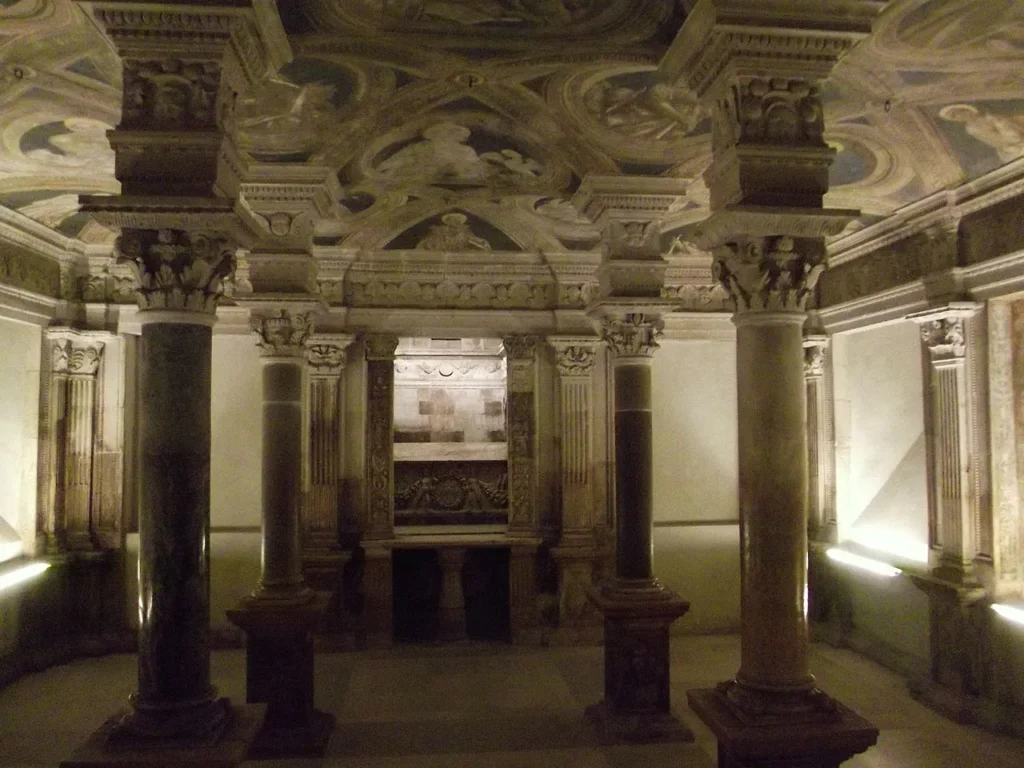
Beneath the presbytery lies the crypt, also known as the Ferrillo chapel, consecrated in 1524. This Renaissance-era structure was rebuilt to resemble the more famous Chapel of the Succorpo of San Gennaro in Naples Cathedral. The crypt consists of a square space with four central columns supporting a lowered cross vault with nine bays.
In front of the entrance, a small altar sits beneath a niche containing the tomb of the Ferrillo family, attributed to Francesco da Milano. This tomb includes portraits of Giacomo Alfonso Ferrillo and Maria Balsa. The crypt’s walls feature recently restored frescoes by Giovanni Todisco of Abriola, representing Saint Andrew, Saint Jerome, the Adoration of the Magi, and the Woman of the Apocalypse. The frescoed vault depicts the Apostles and the four Evangelists, with roundels featuring Saints Francis, Anthony, Bonaventure, and Dominic. To the left of the entrance, a holy water stoup features a relief of four fish.
Feast Day
Feast Day : Assumption of Mary – 15th August
Saint Canius – 29th June
The feast day of the Cathedral of the Assumption of Mary and Saint Canius (Cattedrale di Santa Maria Assunta e San Canio) in Acerenza, Italy, is celebrated on August 15th. This date corresponds to the Feast of the Assumption of the Blessed Virgin Mary, which is an important Catholic feast day celebrating the belief that the Virgin Mary was taken body and soul into Heaven. Additionally, the cathedral is dedicated to Saint Canius, the patron saint of Acerenza, and his feast day is celebrated on June 29th, along with the Feast of Saints Peter and Paul. Both of these significant dates honor the cathedral’s dual dedication to the Virgin Mary and Saint Canius.
Church Mass Timing
Yet to Update
Church Opening Time:
Monday : 9:00 am – 1:00 pm, 4:00 pm – 7:00 pm
Tuesday : 9:00 am – 1:00 pm, 4:00 pm – 7:00 pm
Wednesday : 9:00 am – 1:00 pm, 4:00 pm – 7:00 pm
Thursday : 9:00 am – 1:00 pm, 4:00 pm – 7:00 pm
Friday : 9:00 am – 1:00 pm, 4:00 pm – 7:00 pm
Saturday : 9:00 am – 1:00 pm, 4:00 pm – 7:00 pm
Sunday : 9:00 am – 1:00 pm, 4:00 pm – 7:00 pm
Contact Info
Address :
Largo Duomo, 16, 85011 Acerenza PZ, Italy.
Phone : +393384735594
Accommodations
Connectivities
Airway
Naples (NAP) Airport to Cattedrale di Santa Maria Assunta e San Canio distance between 2 hr 23 min (189.9 km) via A2/E45 and E847.
Railway
Potenza railway station to Cattedrale di Santa Maria Assunta e San Canio distance between 43 min (34.2 km) via SP6.

